Picture this: you’re flipping through Nickelodeon on a Saturday night, SNICK is in full swing, and suddenly there she is.
Amanda Bynes, wide-eyed and fearless, tossing out punchlines faster than you can process them. The sketches are absurd, the characters ridiculous, and yet… you can’t look away. You don’t just laugh, you live in that moment.

Ever catch yourself scrolling past old Nickelodeon clips on YouTube and thinking, “Man, this was peak TV”? You’re not alone.
There’s something about The Amanda Show that hits different. It wasn’t just a sketch comedy, it was a little universe of running gags, wild personalities, and inside jokes you still remember decades later. Judge Trudy’s gavel, Blockblister’s “better” tapes, Penelope Taynt’s obsessive fandom, it’s all burned into the memory like a favorite childhood snack you can still taste.
I remember trying to mimic “Totally Kyle” in front of friends, convinced it was comedy gold. Truth is, we’ve all been there, quoting bits in the schoolyard, half-believing we could land our own Nickelodeon show someday.
Here, we’re going to rewind the tape.
Delve into how The Amanda Show evolved into more than just a kids’ comedy, shaping young humor, inspiring future stars, and leaving a mark that is deeper than most give it credit for.
You might just walk away realizing this so-called “kids’ show” was far more than the sum of its laughs.
It ran for three seasons and 46 episodes, each a mix of wild sketches, recurring characters, and live audience energy. The show’s home was Nickelodeon’s Saturday-night SNICK lineup, prime real estate for kids who refused to give up the TV remote.
Its format was clear but flexible.
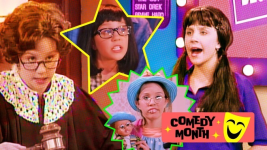
Photo credit: AVClub
At its core, it was a sketch comedy with a “show-within-a-show” premise. Episodes unfolded like a zany variety hour, complete with fake commercials, running gags, and abrupt scene shifts that felt almost rebellious compared to polished sitcoms of the time.
Dan Schneider, already behind hits like All That, created and executive produced the series. He teamed up with Brian Robbins, Mike Tollin, and Joe Davola, while Keiren Fisher, Andrew Hill Newman, and Robin Weiner helped shape the production.
Writers like Christy Stratton and Jenny Kilgen brought sharp parody and offbeat humor, sometimes pulling in absurd setups that seemed impossible to rehearse but somehow landed perfectly.
The show was filmed at Nickelodeon on Sunset in Hollywood, California, right in the middle of a TV era when live audiences still had a powerful influence on comedic timing.
Late ’90s Nickelodeon was on a roll. Kids’ TV wasn’t just background noise, it was appointment viewing. You had All That bringing ensemble sketch comedy, Kenan & Kel delivering sitcom chaos, and Legends of the Hidden Temple feeding competitive daydreams. Into this mix came The Amanda Show, with a style that was sharper, quirkier, and far more self-aware than most of its peers.
Its arrival also marked Nickelodeon’s confidence in Amanda Bynes as a headliner, something rare for a teen performer at the time. She wasn’t just acting in sketches; she was the anchor around which the entire absurd universe spun.

Every sketch seemed to orbit her boundless energy. One moment she was the no-nonsense Judge Trudy, banging her gavel at ridiculous “cases” brought by kids. The next, she was Penelope Taynt, an overly intense superfan determined to meet “Amanda” herself. Her range let the writers go wild—Amanda could be outrageous, sweet, sarcastic, or unhinged without ever losing the audience’s trust.
Her quick shifts in tone gave the show its heartbeat. Even recurring bits, like “The Girls’ Room” or “Blockblister,” stayed fresh because she never played them the same way twice.
For many young viewers, this was their first time seeing a female-led comedy show where the lead wasn’t a sidekick or a romantic subplot, she was the main event.
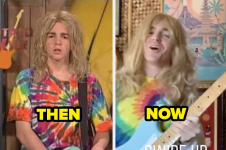
For fans, his chemistry with Amanda was part of the fun. You could see hints of the buddy comedy dynamic that would later define his career. His musical talents even peeked through in certain bits, adding another layer to his appeal.

His physical comedy was fearless, falling, flailing, or breaking into over-the-top reactions at the drop of a hat. The “Dancing Lobster” sketches might be silly on paper, but with Josh’s enthusiasm, they became some of the most replayed moments in fan circles.
Even in supporting roles, he brought a warmth and goofiness that balanced the show’s zany energy. It’s no wonder Nickelodeon saw his potential for bigger projects.

Photo Credit: BusinessInsider
She was the straight-faced teacher, the exasperated mom, or the overdramatic bystander, but she always kept her characters just a little exaggerated. Whether as Mrs. Klutz or Mrs. DeBoat, she could switch from deadpan to absurd in a heartbeat.
Her presence gave the show a bit of grounding. No matter how ridiculous the sketch got, Nancy’s characters often played the “voice of reason”—before inevitably being pulled into the chaos themselves.
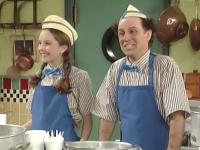
Though both left after season one, their contributions helped establish the show’s rhythm and comedic style.
Gary Anthony Williams added gravitas and absurdity in equal measure. Jeremy Rowley became a fan favorite for his unpredictable characters. These smaller roles filled in the gaps, making the Amanda Show universe feel rich and chaotic.
Together, this cast created a chemistry that was rare for kids’ TV; each person brought a distinct flavor, but none tried to outshine the others. It was an ensemble in the truest sense, anchored by Amanda’s magnetic presence.
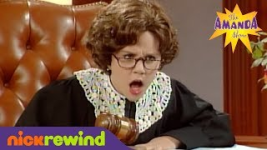
Judge Trudy’s exaggerated gavel slams, over-the-top rulings, and trademark “Bring in the dancing lobsters!” became instant catchphrases. It worked because it let kids imagine a world where their grievances (no matter how silly) were finally taken seriously. And those dancing lobsters? Pure absurdist gold.
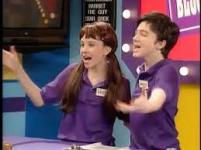
Their motto? “We’re better!”
The gag: every movie they rented was a hilariously awful homemade knockoff. Picture a “Titanic” remake filmed in a bathtub or “Star Wars” acted out in a living room. It wasn’t just a spoof of customer service—it was a gentle jab at our nostalgia for VHS culture itself.
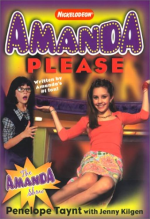
Her long-winded, nasal voice and relentless schemes became a fan favorite. This was one of the earliest Nickelodeon sketches to poke fun at fandom culture before social media amplified it.
Penelope’s scrapbook, her bizarre disguises, and her repeated failure to get close to Amanda gave the show a running subplot that kids could follow week to week.
Sitting on a stool, strumming his guitar, he’d share “deep” life lessons that were hilariously nonsensical. “One time, I saw this bug… and it was crawling on the ground… and then it wasn’t.” The humor came from his commitment to delivering nothing of value—but in such a relaxed way that you couldn’t help but laugh.
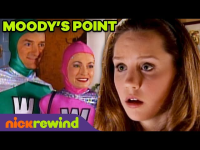
With over-the-top acting, improbable plot twists, and cliffhangers that never resolved, it became a cult favorite. The finale teased answers to big mysteries, like whether Moody would find her lost mother, but the show’s cancellation left it hanging forever.
Fans still debate what the ending might have been, making it one of the great Nickelodeon “what if” moments.
These sketches were the show’s heartbeat. Each one created its own little world, and together they built a universe that kids returned to week after week. The repetition gave comfort, while the constant exaggeration kept it exciting.
All That offered a rotating ensemble cast with sketches that targeted a wide range of humor styles. Amanda Bynes got her big break there, standing out with her sharp timing and fearless delivery.
Both shows thrived on parody, recurring sketches, and a live audience. All That spread the spotlight among multiple cast members, while The Amanda Show put Amanda firmly at the center. This gave the spin-off a more consistent comedic voice.
Absurd situations, physical comedy, and exaggerated characters. Kenan & Kel followed a set narrative each episode, whereas The Amanda Show bounced between wildly unrelated sketches.
The Amanda Show’s unpredictability made it more of a rapid-fire comedy experience.
Starring Drake Bell and Josh Peck, it leaned into sitcom structure but carried over the playful chemistry and comedic beats honed on Amanda’s turf. Comedic timing, absurd setups, and a focus on teen misadventures are some of the similarities of the two.
You may wonder, how do these two differe? Drake & Josh dropped the sketch format in favor of a continuous storyline, giving more room for character development but less for surreal parody.
It regularly poked fun at pop culture, TV formats, and even Nickelodeon itself—a rare move in kids’ programming.
In its prime, The Amanda Show was one of Nickelodeon’s highest-rated live-action programs, drawing in kids, preteens, and even the occasional parent who “just happened” to sit through an episode.
Today, nostalgia keeps it alive through YouTube clips, meme culture, and streaming revivals. Fans still quote lines from sketches like “Blockblister” or “Bring in the dancing lobsters!” proving its comedic shelf life far outlasted its three-year run.
This wasn’t a placeholder—it was a fully built, interactive site. Visitors could play themed games, read “news” about Amanda, and find hidden Easter eggs that tied directly into the show’s sketches. For late ’90s and early 2000s kids, it was a rare example of TV blending with the still-new internet culture.
Its quirky tone matched the show perfectly, and it gave fans a way to “visit” Amanda’s world even after the credits rolled.
The actors inside the lobster suits had only brief windows to perform before visibility and heat became safety concerns. They rehearsed tight choreography to ensure they could nail their goofy entrance and exit without overstaying.
The result? A punchline that always hit fast and left you wanting more.
He praised Amanda for her generosity on set, saying her openness to improv encouraged younger cast members to take comedic risks. Killam’s later success is proof of the show’s role as a training ground for future stars.
Writers Christy Stratton and Jenny Kilgen revealed that during season one, they were forced to split a single salary, a rare but telling glimpse into gender pay inequality in children’s TV production at the time.
While this didn’t affect the quality of the scripts on-screen, it adds a bittersweet footnote to the show’s legacy.
Scripts reportedly included resolving the mystery of Moody’s missing mother and expanding the soap parody’s absurd world. The spin-off never materialized, leaving one of kids’ TV’s most infamous loose ends hanging forever.

It’s not just nostalgia talking, those sketches, those catchphrases, they left a mark deeper than we realized. We’ve revisited the courtroom where Judge Trudy always sided with kids. We’ve laughed at Blockblister’s “better” movies.
We’ve followed Penelope’s hopeless quest and held our breath through Moody’s Point. These weren’t just gags; they were the moments that shaped our sense of humor, our inside jokes, our pop culture memory bank.
We’ve laughed, we’ve cringed, we’ve quoted lines at the most random times. And now we stand at the edge of a truth: The Amanda Show wasn’t just a kids’ comedy; it was a piece of television magic that deserved more credit than it ever got.
So here’s to the dancing lobsters, the bootleg tapes, and the fearless girl who held it all together. The curtain may have fallen in 2002, but the applause? That’s still going.
And if you close your eyes just right, you can almost hear it.
So, what are your fond memories of The Amanda Show? Comment below what it reminds you about.
Amanda Bynes, wide-eyed and fearless, tossing out punchlines faster than you can process them. The sketches are absurd, the characters ridiculous, and yet… you can’t look away. You don’t just laugh, you live in that moment.

Ever catch yourself scrolling past old Nickelodeon clips on YouTube and thinking, “Man, this was peak TV”? You’re not alone.
There’s something about The Amanda Show that hits different. It wasn’t just a sketch comedy, it was a little universe of running gags, wild personalities, and inside jokes you still remember decades later. Judge Trudy’s gavel, Blockblister’s “better” tapes, Penelope Taynt’s obsessive fandom, it’s all burned into the memory like a favorite childhood snack you can still taste.
I remember trying to mimic “Totally Kyle” in front of friends, convinced it was comedy gold. Truth is, we’ve all been there, quoting bits in the schoolyard, half-believing we could land our own Nickelodeon show someday.
Here, we’re going to rewind the tape.
Delve into how The Amanda Show evolved into more than just a kids’ comedy, shaping young humor, inspiring future stars, and leaving a mark that is deeper than most give it credit for.
You might just walk away realizing this so-called “kids’ show” was far more than the sum of its laughs.
An Overview of The Amanda Show and Timeline
From its first laugh track on October 16, 1999, to its bittersweet farewell on September 21, 2002, The Amanda Show carved out a strange little corner of Nickelodeon’s world.It ran for three seasons and 46 episodes, each a mix of wild sketches, recurring characters, and live audience energy. The show’s home was Nickelodeon’s Saturday-night SNICK lineup, prime real estate for kids who refused to give up the TV remote.
Its format was clear but flexible.

Photo credit: AVClub
At its core, it was a sketch comedy with a “show-within-a-show” premise. Episodes unfolded like a zany variety hour, complete with fake commercials, running gags, and abrupt scene shifts that felt almost rebellious compared to polished sitcoms of the time.
Dan Schneider, already behind hits like All That, created and executive produced the series. He teamed up with Brian Robbins, Mike Tollin, and Joe Davola, while Keiren Fisher, Andrew Hill Newman, and Robin Weiner helped shape the production.
Writers like Christy Stratton and Jenny Kilgen brought sharp parody and offbeat humor, sometimes pulling in absurd setups that seemed impossible to rehearse but somehow landed perfectly.
The show was filmed at Nickelodeon on Sunset in Hollywood, California, right in the middle of a TV era when live audiences still had a powerful influence on comedic timing.
Late ’90s Nickelodeon was on a roll. Kids’ TV wasn’t just background noise, it was appointment viewing. You had All That bringing ensemble sketch comedy, Kenan & Kel delivering sitcom chaos, and Legends of the Hidden Temple feeding competitive daydreams. Into this mix came The Amanda Show, with a style that was sharper, quirkier, and far more self-aware than most of its peers.
Its arrival also marked Nickelodeon’s confidence in Amanda Bynes as a headliner, something rare for a teen performer at the time. She wasn’t just acting in sketches; she was the anchor around which the entire absurd universe spun.
Landmark Events and Changes
A few milestones stand out:- Cast changes: John Kassir and Raquel Lee left after the first season, making room for Josh Peck in season two—a move that would later pay off in Drake & Josh.
- AmandaPlease.com: A real, functioning tie-in website launched alongside the show. Packed with games, Easter eggs, and fake news articles, it was a glimpse into the early days of internet–TV integration.
- Unfinished business: The last season ended abruptly, leaving the spoof soap “Moody’s Point” unresolved. Fans never got closure, though rumors suggest a spin-off was planned.
Main Cast and Memorable Characters
Amanda Bynes
Amanda wasn’t just the star; she was the show.
Every sketch seemed to orbit her boundless energy. One moment she was the no-nonsense Judge Trudy, banging her gavel at ridiculous “cases” brought by kids. The next, she was Penelope Taynt, an overly intense superfan determined to meet “Amanda” herself. Her range let the writers go wild—Amanda could be outrageous, sweet, sarcastic, or unhinged without ever losing the audience’s trust.
Her quick shifts in tone gave the show its heartbeat. Even recurring bits, like “The Girls’ Room” or “Blockblister,” stayed fresh because she never played them the same way twice.
For many young viewers, this was their first time seeing a female-led comedy show where the lead wasn’t a sidekick or a romantic subplot, she was the main event.
Drake Bell
Before Drake & Josh, Drake Bell cut his teeth here, popping up as characters like Tony Pajamas, a wannabe mobster with a knack for slapstick mishaps, and the endlessly chilled-out Totally Kyle. He played the goofy best friend, the clueless customer, or the overconfident teen with equal commitment.
For fans, his chemistry with Amanda was part of the fun. You could see hints of the buddy comedy dynamic that would later define his career. His musical talents even peeked through in certain bits, adding another layer to his appeal.
Josh Peck
Josh didn’t arrive until season two, but he wasted no time making an impression.
His physical comedy was fearless, falling, flailing, or breaking into over-the-top reactions at the drop of a hat. The “Dancing Lobster” sketches might be silly on paper, but with Josh’s enthusiasm, they became some of the most replayed moments in fan circles.
Even in supporting roles, he brought a warmth and goofiness that balanced the show’s zany energy. It’s no wonder Nickelodeon saw his potential for bigger projects.
Nancy Sullivan
As the resident “adult” in a kids’ comedy, Nancy Sullivan had a tricky job.
Photo Credit: BusinessInsider
She was the straight-faced teacher, the exasperated mom, or the overdramatic bystander, but she always kept her characters just a little exaggerated. Whether as Mrs. Klutz or Mrs. DeBoat, she could switch from deadpan to absurd in a heartbeat.
Her presence gave the show a bit of grounding. No matter how ridiculous the sketch got, Nancy’s characters often played the “voice of reason”—before inevitably being pulled into the chaos themselves.
John Kassir & Raquel Lee
In the first season, John Kassir brought fast-talking energy to roles like Mr. Gullible and the Blockblister manager, while Raquel Lee’s timing and expressive delivery made even minor roles stand out.
Though both left after season one, their contributions helped establish the show’s rhythm and comedic style.
Supporting Cast of The Amanda Show
The supporting bench was deep. Taran Killam, who’d go on to SNL, honed his comedic chops here.Gary Anthony Williams added gravitas and absurdity in equal measure. Jeremy Rowley became a fan favorite for his unpredictable characters. These smaller roles filled in the gaps, making the Amanda Show universe feel rich and chaotic.
Together, this cast created a chemistry that was rare for kids’ TV; each person brought a distinct flavor, but none tried to outshine the others. It was an ensemble in the truest sense, anchored by Amanda’s magnetic presence.
Sketches That Defined The Amanda Show
Judge Trudy
A parody of Judge Judy, this sketch flipped the courtroom dynamic on its head; kids were always right, and adults inevitably paid the price.
Judge Trudy’s exaggerated gavel slams, over-the-top rulings, and trademark “Bring in the dancing lobsters!” became instant catchphrases. It worked because it let kids imagine a world where their grievances (no matter how silly) were finally taken seriously. And those dancing lobsters? Pure absurdist gold.
Blockblister
Back when video rental stores were a Friday-night ritual, The Amanda Show gave us Blockblister, an off, brand Blockbuster run by the Blokey family.
Their motto? “We’re better!”
The gag: every movie they rented was a hilariously awful homemade knockoff. Picture a “Titanic” remake filmed in a bathtub or “Star Wars” acted out in a living room. It wasn’t just a spoof of customer service—it was a gentle jab at our nostalgia for VHS culture itself.
Penelope Taynt
Penelope, played by Amanda herself, was an obsessive superfan determined to meet Amanda Bynes “in person.”
Her long-winded, nasal voice and relentless schemes became a fan favorite. This was one of the earliest Nickelodeon sketches to poke fun at fandom culture before social media amplified it.
Penelope’s scrapbook, her bizarre disguises, and her repeated failure to get close to Amanda gave the show a running subplot that kids could follow week to week.
Totally Kyle
Drake Bell’s Totally Kyle was the embodiment of surfer-dude laziness.Sitting on a stool, strumming his guitar, he’d share “deep” life lessons that were hilariously nonsensical. “One time, I saw this bug… and it was crawling on the ground… and then it wasn’t.” The humor came from his commitment to delivering nothing of value—but in such a relaxed way that you couldn’t help but laugh.
Moody’s Point
This soap opera parody ran as a recurring segment, slowly building into a surreal teen drama.
With over-the-top acting, improbable plot twists, and cliffhangers that never resolved, it became a cult favorite. The finale teased answers to big mysteries, like whether Moody would find her lost mother, but the show’s cancellation left it hanging forever.
Fans still debate what the ending might have been, making it one of the great Nickelodeon “what if” moments.
These sketches were the show’s heartbeat. Each one created its own little world, and together they built a universe that kids returned to week after week. The repetition gave comfort, while the constant exaggeration kept it exciting.
5 Shows That Came Close to The Amanda Show
All That
If The Amanda Show was the zany spin-off, All That was its parent.All That offered a rotating ensemble cast with sketches that targeted a wide range of humor styles. Amanda Bynes got her big break there, standing out with her sharp timing and fearless delivery.
Both shows thrived on parody, recurring sketches, and a live audience. All That spread the spotlight among multiple cast members, while The Amanda Show put Amanda firmly at the center. This gave the spin-off a more consistent comedic voice.
Kenan & Kel
Another Nickelodeon hit of the late ’90s, Kenan & Kel was a sitcom, not a sketch show. But its sense of playful chaos and overblown scenarios felt familiar.Absurd situations, physical comedy, and exaggerated characters. Kenan & Kel followed a set narrative each episode, whereas The Amanda Show bounced between wildly unrelated sketches.
The Amanda Show’s unpredictability made it more of a rapid-fire comedy experience.
Drake & Josh
This was the most direct spiritual successor, launched after The Amanda Show ended.Starring Drake Bell and Josh Peck, it leaned into sitcom structure but carried over the playful chemistry and comedic beats honed on Amanda’s turf. Comedic timing, absurd setups, and a focus on teen misadventures are some of the similarities of the two.
You may wonder, how do these two differe? Drake & Josh dropped the sketch format in favor of a continuous storyline, giving more room for character development but less for surreal parody.
Style & Humor Comparisons
Where All That was a playground of diverse voices and Kenan & Kel thrived on buddy chemistry, The Amanda Show built a brand on sharp satire and exaggerated absurdity.It regularly poked fun at pop culture, TV formats, and even Nickelodeon itself—a rare move in kids’ programming.
In its prime, The Amanda Show was one of Nickelodeon’s highest-rated live-action programs, drawing in kids, preteens, and even the occasional parent who “just happened” to sit through an episode.
Today, nostalgia keeps it alive through YouTube clips, meme culture, and streaming revivals. Fans still quote lines from sketches like “Blockblister” or “Bring in the dancing lobsters!” proving its comedic shelf life far outlasted its three-year run.
Top 5 Surprising Facts About The Amanda Show
1. AmandaPlease.com Was a Real, Fully Functional Website
Long before social media fandoms, The Amanda Show had AmandaPlease.com.This wasn’t a placeholder—it was a fully built, interactive site. Visitors could play themed games, read “news” about Amanda, and find hidden Easter eggs that tied directly into the show’s sketches. For late ’90s and early 2000s kids, it was a rare example of TV blending with the still-new internet culture.
Its quirky tone matched the show perfectly, and it gave fans a way to “visit” Amanda’s world even after the credits rolled.
2. The Dancing Lobsters Had Strict Stage Rules
Those random bursts of dancing crustaceans in Judge Trudy weren’t improvised chaos.The actors inside the lobster suits had only brief windows to perform before visibility and heat became safety concerns. They rehearsed tight choreography to ensure they could nail their goofy entrance and exit without overstaying.
The result? A punchline that always hit fast and left you wanting more.
3. Taran Killam Credits Amanda Bynes for Launching His Career
In a 2025 interview, SNL alum Taran Killam looked back at his time on the show and called it a pivotal break.He praised Amanda for her generosity on set, saying her openness to improv encouraged younger cast members to take comedic risks. Killam’s later success is proof of the show’s role as a training ground for future stars.
4. One Salary for Two Writers
Behind the laughs, there were less cheerful realities.Writers Christy Stratton and Jenny Kilgen revealed that during season one, they were forced to split a single salary, a rare but telling glimpse into gender pay inequality in children’s TV production at the time.
While this didn’t affect the quality of the scripts on-screen, it adds a bittersweet footnote to the show’s legacy.
5. The “Moody’s Point” Ending Was Planned to Spin Off Into Its Own Show
The cliffhanger wasn’t meant to be a cruel joke; Nickelodeon had intended to develop “Moody’s Point” as a separate series.Scripts reportedly included resolving the mystery of Moody’s missing mother and expanding the soap parody’s absurd world. The spin-off never materialized, leaving one of kids’ TV’s most infamous loose ends hanging forever.

One Last Trip Down Memory Lane
Ever find yourself wishing you could relive those Saturday nights when the TV glowed with Nickelodeon’s chaos, and Amanda Bynes was running the whole show?It’s not just nostalgia talking, those sketches, those catchphrases, they left a mark deeper than we realized. We’ve revisited the courtroom where Judge Trudy always sided with kids. We’ve laughed at Blockblister’s “better” movies.
We’ve followed Penelope’s hopeless quest and held our breath through Moody’s Point. These weren’t just gags; they were the moments that shaped our sense of humor, our inside jokes, our pop culture memory bank.
We’ve laughed, we’ve cringed, we’ve quoted lines at the most random times. And now we stand at the edge of a truth: The Amanda Show wasn’t just a kids’ comedy; it was a piece of television magic that deserved more credit than it ever got.
So here’s to the dancing lobsters, the bootleg tapes, and the fearless girl who held it all together. The curtain may have fallen in 2002, but the applause? That’s still going.
And if you close your eyes just right, you can almost hear it.
So, what are your fond memories of The Amanda Show? Comment below what it reminds you about.

